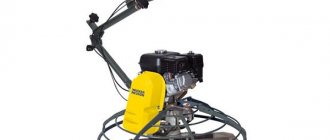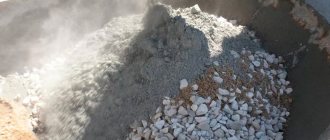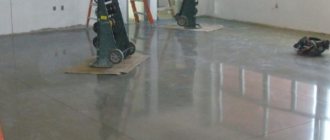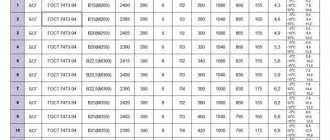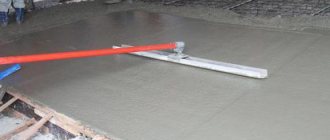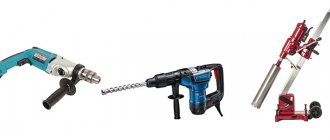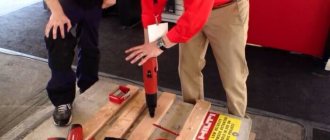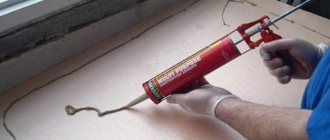Almost any concrete surface has fairly high strength characteristics and increased density. That is why when processing it, special milling machines with different attachments are used, depending on the type of surface and the type of work performed. You will learn what a concrete milling cutter is and how the concrete surface is milled using one or another device by reading our article.
The photo shows a milling machine for concrete surfaces
Scope of equipment
During the construction of most residential and non-residential buildings, concrete floors are poured. Often, when repairing concrete pavements from an old, delaminating and contaminated layer, as well as when pouring new floors, concrete milling machines are used.
Concrete milling is carried out in the following cases:
- If it is necessary to remove a small layer of coating with a thickness of 5–10 mm , for example polymer or magnesium;
- If partial leveling of the base is required before subsequent laying on the surface of floor coverings such as linoleum, laminate or parquet boards;
- If it is necessary to give the base some roughness to prevent slipping , for example in production facilities, warehouse boxes, parking areas, and so on;
- For removing a layer of mineral-based polymer floors from the base in case of violation of the pouring technology, as well as for removing exfoliated old cement-sand screed and cleaning the surface layer for the use of the coating in the residential and non-residential sectors.
Removing sand-cement screed
Grinding and milling of concrete
Leveling the concrete surface, as an independent process of construction work or as a preparatory stage for applying a self-leveling floor, is an important event on which the quality of the final finishing floor covering largely depends.
Specialists of the Polymer Systems perform all types of work on leveling the concrete surface: concrete grinding, shot blasting, concrete milling. There is a full range of professional equipment for working with concrete and marble.
Small irregularities up to 2 mm, surface defects and cement laitance formed after laying fresh concrete are eliminated by grinding the concrete with a mosaic grinder with diamond or corundum segments. Cement laitance must be removed before laying any self-leveling floors, as it prevents the polymer from penetrating into stronger layers of concrete, that is, it reduces the adhesion of dissimilar materials. When choosing a segment for grinding, the grade strength of the concrete is taken into account. For concrete with grade strength below M250, corundum segments are used, for concrete grades M300 and above, diamond segments are used. Old paints and flaking thin-layer polymer coatings are removed using a special attachment for a grinding machine, which is a metal brush. Bush hammers - metal drums with carbide needle tipped parts - are used as exotic methods for rough processing of concrete surfaces.
The cost of grinding concrete is 70 rubles/m2. I want it cheaper!
labor and material costs . Namely: grinding concrete with diamond segments using a mosaic grinding machine to a depth of 2 mm, opening the pores of durable concrete, cleaning the surface with an industrial vacuum cleaner.
If the unevenness of the concrete floor is serious (more than 2 mm) or it is necessary to remove the old self-leveling coating, use a milling machine , where carbide lamellas are used as a cutting tool. After each pass along the concrete surface, the milling cutter leaves behind grooves with a ridge height of up to 4 mm, which are removed by grinding after milling.
The cost of milling concrete is 90 rubles/m2. I want it cheaper!
labor and material costs . Namely: milling concrete with a milling machine to a depth of 4 mm per pass, cleaning the surface with an industrial vacuum cleaner.
A prerequisite for grinding and milling work is the absence of metal reinforcing mesh or reinforcement in the upper layers of the concrete floor, since their presence can damage the planetary mechanism on the grinding machine and the rotating shaft on the cutter. If metal is still present in the concrete, it is cut out manually with grinders.
Grinding and milling of concrete is carried out “dry”, that is, the surface is not wetted with water. This is done to increase the efficiency of both processes, since with the use of water, the resulting wet sludge clogs the cutting elements of the machines and reduces surface friction. Thus, during grinding and milling, a large amount of dust is generated, including fine dust. For effective dust removal, industrial vacuum cleaners are connected to grinding and milling machines. But grinding and milling are not completely dust-free.
Important! Grinding and milling concrete only smoothes the surface, removing its various defects and ripples, but does not even out wave differences. Wave changes can only be eliminated by completely refilling the concrete floor. The surface can be significantly leveled by alternating geodetic surveying of an uneven area and its successive grinding.
Type and design features of devices
- Equipment for processing concrete foundations consists of:
- Welded metal frame with convenient control levers and for movement the equipment is equipped with a small rubber chassis;
- The propulsion system for cutting tools is an electric or pneumatic engine model, as well as a diesel one;
- As the basis for the cutting element, a special drum drive is used, on which a cutter is mounted, with the help of which concrete is milled.
Milling cutter
Equipment motor type
To carry out certain work, an appropriate concrete milling machine, equipped with a diesel, gasoline or electric drive, is selected. The engine power is also selected depending on the type and volume of work performed.
Diesel milling unit
For indoor work, it is advisable to use electric or pneumatic motors that do not emit harmful carbon dioxide gases. But for carrying out work in open space, for example, at airports for processing runways, a gasoline or diesel drive is quite suitable.
Electric drive machines are more popular as they are more economical and practical, but with the help of such devices, work can only be performed if the facility is supplied with electricity, for example, from the electrical network, and in its absence, there is a need to use generator sets. Also, these electric machines are less preferable in the case of fairly large volumes of work.
Some equipment models are capable of operating from a 380V power supply; such models are more productive, and with their help it is possible to process fairly large volumes of work, for example, in factory or warehouse premises.
Cutting elements of devices
Milling of concrete floors is carried out using a drum mechanism, on which various types of cutting elements are installed. The drum with cutters is driven by a drive, in which the main role is played by the engine.
Milling cutter for concrete. Drum with cutters made of high-strength steel
Depending on the type of work performed, an appropriate machine with certain types of cutters is selected. The device is equipped with chain-driven shafts ranging from 4–9 pcs. depending on the type of machine. The cutters themselves (lamellas) are installed on the base of the drum drive in a checkerboard pattern, which ensures complete overlap and high-quality processing of the base.
Cutters in action
These or other cutters can be used to process both soft surfaces (for example, milling asphalt concrete pavement) and hard surfaces (concrete or stone).
Using cutters it is quite easy to remove any paint coating, give some roughness to the floor and remove raised irregularities.
Some modern machines are equipped with unique, patented trefoil-shaped cutters. Perforation of the cutting element allows you to capture a large area of the processed surface and at the same time control the deformation of the cutter. These types of cutters are more productive and in some cases can replace standard lamellas.
The special heavy-duty type of steel used to cast the large and small die cutting element allows it to be used for processing concrete or asphalt surfaces, as well as for leveling and cleaning them.
Pneumatic asphalt milling cutter
Chip cutting elements with a width of 11–39 mm are used in the processing of asphalt sheets with a thermoplastic coating.
Using cutters of round diameter, a concrete floor having a large area is milled.
Nozzles in the form of a metal bristly base are suitable for cleaning the surface of various materials from traces of rust, scale, oil, fuel oil and other types of contaminants.
Important: When installing cutting parts on equipment, you must ensure that they are in the correct position. So the cutting edge should be positioned only in the direction of rotation of the drum.
What else are concrete cutters used for?
In addition to leveling the surface of a concrete floor, milling machines are used to remove old polymer coating, remove the hardened top layer of concrete (Master Top), create slopes and slopes to drains, remove tiles from the concrete surface, clean the surface of the concrete floor from oil contamination and so on. In some cases, milling is used on inclined concrete surfaces (ramps) and pedestrian areas to give them anti-slip properties. It is necessary to understand that eliminating large bumps with a height of more than 30 mm on a concrete floor is not economically profitable due to the high cost of consumables (drum, axle, sprocket), sometimes it is easier to pour a new concrete screed, followed by processing with trowels that remove sagging, sharp depressions.
Milling technological process
The base is processed by applying longitudinal grooves to the surface using a machine in the first pass. Next, the grooves are applied in a perpendicular manner, thus creating a lattice of longitudinally perpendicular lines, which are subsequently ground and, as a result, completely removed with a grinding machine with appropriate attachments.
If the required result was not achieved during the first run, the operation is repeated again.
Applying longitudinal furrows
In most cases, the surface milling procedure is carried out in enclosed residential and non-residential premises where the level of ventilation is insufficient. Therefore, it is advisable to connect powerful construction vacuum cleaners to the housing structure to ensure removal of sludge and dust, which quickly disables the cutters and the entire drive mechanism of the machine.
In addition, the premises provide normal working conditions, which is important and, of course, necessary.
Milling a concrete floor
Note: If vacuum cleaners are not available, it is possible to slightly moisten the surface layer with water using special sprayers. It is strictly forbidden to use electric milling machines in the open air during rainy and snowy weather, especially machines operating under voltage of 380V (Danger to life!). When working with these units, it is necessary to follow the instructions and technology.
Cutting reinforced concrete with diamond wheels, as well as brick and any other hard surfaces, is carried out in accordance with the technology for carrying out construction and repair work in residential and non-residential premises, as well as diamond drilling of holes in concrete.
An electric milling cutter for aerated concrete is somewhat different from milling cutters for processing concrete bases. Aerated concrete blocks have a porous structure, consisting of so-called light cellular concrete, which is less strong than the concrete base.
Using these machines, they cut aerated concrete blocks and make special groove channels for plumbing and electrical wiring, and also form grooves for laying reinforcing elements under reinforcing belts, which are then filled with concrete mortar.
Milling cutter for aerated concrete
Summing up, drawing conclusions
So, we hope in our article, you received the answer to the question of what a concrete milling machine is, as well as for what purposes these devices are used, and what kind of equipment is used to perform certain types of work. For the most part, these machines are used in the processing of concrete floor coverings, as well as asphalt concrete, and are used almost everywhere.
The devices are quite easy to operate and therefore, with their help, some types of work can be done with your own hands without resorting to the services of specialized companies, especially since the price for these services is relatively high.
For clarity, we recommend that you watch the video in this article, which shows the process of processing a concrete floor surface.
Processing process
In fact, milling technology is not as complicated as it seems: as mentioned above, you need to have a machine with cutting diamond segments. First, a special star-shaped tool processes the surface of the drum, then it is driven into rotation, and centrifugal force is generated along its transverse axis. The torque pressure causes the cutter to eject - it comes into contact with the surface and the cutting/splitting process begins. For the final stage, a mosaic grinder is used - it eliminates sharp peaks on the concrete surface. To achieve an ideal coating condition, you need to replace the diamond segment with abrasive triangular stones and carry out processing.
Note!
The force of the impact affects the layer that is removed during milling: the greater it is, the thicker the layer, respectively.
